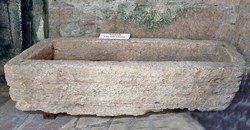


An entry in the Roman Martyrology under 1st September records:
-
“At Todi in Umbria, St Terentian, bishop and martyr. Under Emperor Hadrian, by order of the proconsul Laetian, he was racked, scourged with whips set with metal, and finally having had his tongue cut out. He ended his martyrdom by undergoing capital punishment”.
St Terentian is recorded in the Hieronymian Martyrology as a bishop who was martyred in “Tudertina Tuscia”.
The legend of St Terentian survives in three versions (BHL 8000-3): a copy of BHL 8001 is preserved under 1st September in the Leggendari del Duomo. The legend records that the aged St Terentian, bishop of Todi, was denounced by the Urban Prefect Mariano during the reign of the Emperor Hadrian (117-38). He was duly arrested by Letianus, the proconsul of Tuscia. He professed his faith in the Trinity and refused to sacrifice to Jove and Hercules: at that instant, the statues were miraculously smashed and a pagan priest called Flaccus was blinded. St Terentian was condemned to death, but when Flaccus prostrated himself before him, he restored his sight and baptised him at his own request. Both men were beheaded on 1st September, on the banks of the Tiber outside Todi. The next night, a priest called Esuperantius and a lady called Laurentia recovered the bodies and buried them at Colonia, better known as "Petroso", (the rocky place), some 8 Roman miles outside Todi.
According to Emore Paoli (referenced below, at p. 514-5), the legend stresses the trinitarian nature of Terentian’s preaching. He suggested that it had been used by anti-Arian missionaries in Lombard Italy, which suggested a date between the mid 6th and the early 7th century.
The legend of St Juvenal of Narni (BHL 4614) says that, when he arrived in Narni in 364, the city remained Pagan, despite the efforts there of by St Terentian of Todi, St Felician of Foligno and St Valentine of Terni.
Relics
An oratory was built above the burial place of SS Terentian and Flaccus, at what became the village of San Terenziano outside Todi. The double church of SS Terenziano e Flacco was built over it in the 11th century. [See this page in the site “Santuari dell’Umbria”.]
In 1715, the sarcophagus believed to contain the relics of St Terentian was retrieved from a grotto that had been excavated from the rock behind the altar of the lower church of SS Terenziano e Flacco. Unfortunately, the lid of the sarcophagus was smashed in the process. The relics were therefore transferred to a new sarcophagus and translated to the high altar of the upper church. Bishop Ludovico Anselmo Gualterio formally recognised the relics as those of St Terentian at that time. The original sarcophagus, which is made from local travertine, remains in the lower church.
However, there are traditions that speak to the dispersion of at least some of the relics of St Terentian:
-
✴According to BHL 8004, Laurentia took a relic of the arm of St Terentian to Teano, north of Naples. Bishop Mauro built the Duomo there, which was dedicated to St Terentian, in the early 9th century, but this was destroyed in 1060. The presumed relic survives, and St Terentian is a patron saint of Teano.
-
✴Count Pandolfo II of Anguillara gave what he claimed was relics of St Terentian to the town of Capranica (near Viterbo) when he acquired it in 1260. He probably acquired the relic itself in 1254, when he led the papal army that suppressed a Ghibelline revolt at Todi. These relics also survive, and St Terentian is a patron saint of Capranica.
Diffusion of the Cult
St Terentian is widely venerated: many of the places where he is still honoured are near Genoa or in Emilia. It is likely that pilgrims returning from Rome to France brought the cult with them. A video on this website describes the phenomenon.
Read more:
E. Paoli, “ L' Agiografia Umbra Altomedievale”, in
“Umbria Cristiana: dalla Diffusione del Culto al Culto dei Santi (secc. IV-X): Atti del XV Congresso Internazionale di Studi sull' Alto Medioevo (Spoleto, 23-28 Ottobre 2000)”, Spoleto (2001) pp 479-529
L. Zaffarami, “San Terenziano: Primo Vescovo e Martire di Todi e San Flacco, suo Compagno di Martirio e di Sepoltura”, (1935) Todi
Return to Saints of Todi.
Return to the home page on Todi.

